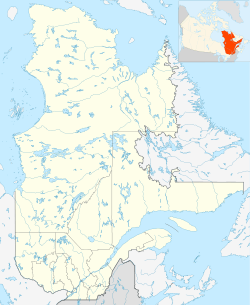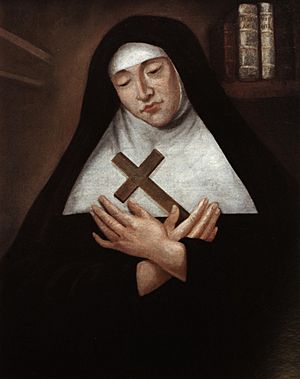Ursulines of Quebec facts for kids
| Monastère des Ursulines de Québec | |
 |
|
| Monastery information | |
|---|---|
| Order | Ursulines |
| Established | 1639 |
| Mother house | Ursuline Monastery of Tours |
| Diocese | Archdiocese of Quebec |
| People | |
| Founder(s) | St. Marie of the Incarnation, O.S.U. |
| Important associated figures | Mother Geneviève Boucher, O.S.U.; Jeanne Le Ber; St. Marie-Marguerite d'Youville, S.G.M. |
| Architecture | |
| Functional Status | active |
| Designated date | 1972 |
| Groundbreaking | 1641 |
| Completion date | 1642 |
| Site | |
| Location | Quebec City, Quebec, Canada |
| Coordinates | 46°48′44″N 71°12′29″W / 46.812094°N 71.208127°W |
| Public access | yes |
| Established | 1936 |
|---|---|
| Type | religious museum and teaching centre |
The Ursuline Monastery of Quebec City (French: Monastère des Ursulines de Québec) was founded in 1639. It was started by a group of Ursuline nuns led by Mother Marie of the Incarnation. This monastery is the oldest place of learning for girls and women in North America.
Today, the monastery is the main home for the Ursuline Sisters of the Canadian Union. The sisters there also run a historical museum. They continue to use the monastery as a teaching center. In 1972, the entire complex was named a National Historic Site of Canada.
Contents
What are the Ursulines?
The Ursulines are a Roman Catholic religious group. They were started in Italy by Angela de Merici in 1535. Their main goal was to educate girls and care for people who were sick or in need. Their special protector is Saint Ursula.
New France was the name for the areas in North America that France explored and settled. This began when Jacques Cartier explored the Saint Lawrence River in 1534. Later, in 1608, the French explorer Samuel de Champlain founded Québec. It became the main city for New France.
Life for the early settlers was very hard. Many people died because of the cold weather and diseases. In 1630, only 103 colonists lived there. But by 1640, the number grew to 355.
History of the Ursuline Monastery
The Ursuline Sisters were the first Catholic nuns to arrive in New France, which is now Canada. Their story in Quebec began on August 1, 1639. That's when the first sisters landed in Canada.
The monastery was started by Mother (now Saint) Marie of the Incarnation (1599–1672). She was an Ursuline nun from a monastery in Tours, France. She was joined by Madame Marie-Madeline de Chauvigny de la Peltrie (1603–1671). Madame de la Peltrie was a wealthy widow from France. King Louis XIII officially approved the founding of the monastery in 1639.
When the nuns arrived, they first learned the languages of the local native peoples. Then, they began to teach the native children. They taught them how to read and write. They also taught skills like needlework, embroidery, drawing, and other home arts.
After three years in the Lower Town of Quebec City, the nuns moved. They built a new monastery on land given to them by the Company of New France. Their first students were Indigenous girls. The nuns had more success teaching them than the Jesuits had with Indigenous boys.
The first monastery building burned down in 1650. However, it was quickly rebuilt. The community faced attacks from the Iroquois in 1661–1662. During this time, one of their priests was killed near Montreal.
The rules for the Ursuline sisters were written by Father Jérôme Lalemant. These rules were followed until 1681. That's when Bishop François de Laval decided they should follow rules that included a special promise. This promise meant the sisters would always teach girls.
The monastery survived two major attacks on Quebec. The first was in 1690, during a siege and bombing by William Phips. The second was on September 13, 1759, during the Battle of the Plains of Abraham. In this battle, the French army in Quebec was defeated by the British army led by James Wolfe.
After the battle, the French governor, Montcalm, who died in the fight, was buried at night in the monastery chapel. The first English governor, Murray, even used part of the monastery as his headquarters. During this time, the nuns helped care for the wounded and sick. The food they received for this work saved them from starving. Both French and English governors were always friendly to the monastery.
The Quebec Monastery helped start new Ursuline communities. These included ones in Three Rivers in 1697, Roberval in 1882, Stanstead in 1884, and Rimouski in 1906. They also sent sisters to places like New Orleans in 1822 and Boston in 1824.
Growth and New Communities
The Ursuline Monastery of Quebec, founded in 1639, helped create many other monasteries and convents. These new places were independent until 1953. Some of the places they founded include:
- Monastery of Trois-Rivières: (1697)
* This monastery later helped start communities in Waterville (1888), Skowhegan, USA (1899), Grand-Mère (1900), and Shawinigan (1908).
- Monastery of Roberval: (1882–2002). The sisters moved to a new residence in Roberval in 2002.
- Monastery of Stanstead: (1884–2004). The sisters moved to Magog in 2004.
- Monastery of Rimouski: (1906–1970). This monastery later became the Université du Québec à Rimouski.
- Monastery of Gaspe: (1924–1970). This monastery also helped start several smaller communities.
- Sendai, Japan: (1936). This community also led to others in Japan.
- Loretteville: (1941). This was a boarding school and day school.
In 2018, the Ursuline community in Quebec City saw a big change. Out of 52 sisters, 48 moved to a care facility. Only four sisters remained at the monastery. This showed how the community was changing as the sisters grew older. The monastery's large wooden door, designed to keep outsiders out, could not stop the changes of time.
Important People Connected to the Monastery
Mother Marie of the Incarnation, the founder, had a special devotion to the Sacred Heart of Jesus. She started this practice in the monastery many years before it became widely known. The first celebration of this devotion in the New World happened at the monastery on June 18, 1700. Mother Marie was also very skilled with languages. She created dictionaries for the Algonquin and Iroquois languages. She also wrote a sacred history in Algonquin and a catechism (a book of religious teachings) in Iroquois.
Geneviève Boucher, also known as Mère de Saint-Pierre, lived from 1676 to 1766. She served the Ursuline Order for over 60 years. She is remembered as a "perfect Ursuline" and a very long-serving member. Anne Bourdon, known as Mère de Sainte-Agnès (1644-1711), was the first superior (leader) of the order who was born in Canada.
After England took control of the colony in 1760, the first superior elected was Esther Wheelwright. She was a girl from New England who had been captured by the Abenaki people. A Jesuit priest rescued her, and she became a special friend of the first governor, Vaudreuil. Many important women from Irish, Scottish, and American backgrounds joined this monastery. One notable person was Mother Cecilia O'Conway, the first nun from Philadelphia.
The list of former students includes Jeanne Le Ber (1662–1714), a very religious woman known as the "recluse of Montreal." Another famous former student was Saint Marie-Marguerite d'Youville (1701–1771). She founded the Grey Sisters in Montreal.
During the French Revolution (1789–1799), several French refugees served as chaplains (priests) at the monastery. One of the most famous was Abbé L.P. Desjardins. He later became a high-ranking church official in Paris. Through him, many valuable paintings were brought to the chapel. These paintings were by famous artists like Philippe de Champaigne and Charles Le Brun.
Museum Connections
The Museum of the Ursuline Monastery is connected with several important organizations. These include the CMA, the CHIN, and the Virtual Museum of Canada.






